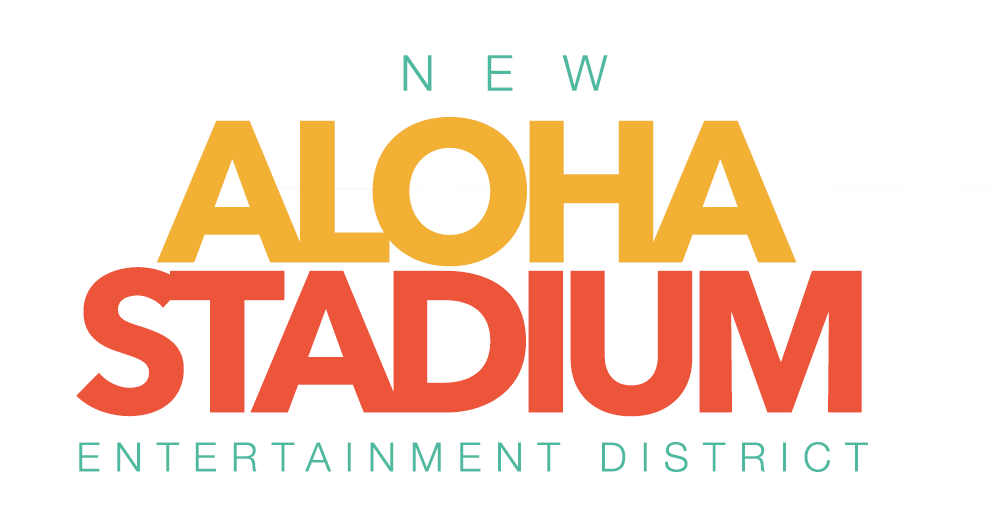Questions and Clarifications Pertaining To The New Aloha Stadium Entertainment District (NASED) Project
- The goal of the NASED development has never been to bring Waikiki tourism to Aiea. Rather, the intention of the NASED project is to capitalize on the thousands of residents and existing visitors who visit the current Aloha Stadium area every year. The Entertainment District seeks to provide people who attend concerts, football games, the 50th State Fair, the Swap Meet, the Great Aloha Run, and many other events, in addition to those who visit neighboring Pearl Harbor, with the opportunity to come early, stay late, and spend money within the district to produce revenue and benefits for the state and the greater community.
- A critical component of the NASED project are the numerous community benefits within the development which serve residents and visitors of the adjacent communities and future residents who will live on the NASED site. These benefits, such as open parks; a potential amphitheater, museum, or cultural/educational facilities; walking trails and bike paths; and others, are all made possible due to the increased revenues generated by tapping into the stream of kamaaina and visitors who have made the existing Aloha Stadium successful for over four decades. Additionally, the NASED project will include residential and retail space. This mix provides stadium patrons with diverse amenities, and also gives residents in the adjacent neighborhoods access to new food and beverage, retail, and other commercial options which are not currently present. A financial goal of the NASED project is to provide economic diversity to the local economy by providing numerous additional revenue-producing amenities for members of the community and visitors alike, beyond the existing Aloha Stadium and parking lot.
The NASED project increases the area’s desirability for a hotel (or hotels) on site for a few key reasons. First and foremost, the existing Aloha Stadium site consists of the stadium surrounded by empty surface parking lots. The Entertainment District will offer food and beverage options, retail, parks and walking paths, in addition to the new stadium facility. A hotel (or hotels) on site is a natural complement to the new NASED that will provide visiting athletes and performers (including from the neighbor islands), tourists, locals, and others a place to stay on site and continue to enjoy amenities within the district. It is especially important that this hospitality destination will focus more on business, local, and district-oriented visitors, and not be a tourism-centric resort that competes with Waikiki.
Prior to the COVID-19 pandemic, the existing Aloha Stadium hosted a five-year average of 50-plus sports events as well as numerous concerts, graduations, and others. All of these events are affected if the stadium becomes unavailable due to safety concerns. However, it should be noted that the existing Aloha Stadium field is still capable of hosting events. The grandstands themselves cannot accommodate patrons, but televised events such as UH and high school football games can take place on the stadium field without fans.
The state is committed to keeping the procurement process for creating NASED transparent and open. The state is following standard procurement procedures and the letter of the law while putting together the eventual Public-Private Partnership (P3) agreement with the selected developer(s). The deteriorating state of the existing stadium has caused operational issues for the facility, but it has not necessitated any cutting of corners procedurally to rush the project to fruition.
- As the state’s largest venue, Aloha Stadium is the natural home for major sporting and entertainment events. A primary goal of the NASED development is to maximize that experience. An entertainment district is about having a sense of arrival, place, public amenity, and engaging in food, drink, retail, and general enjoyment activities even when there is no event occurring in the stadium. To the extent that the district can achieve this AND offer much-in-demand space for housing and commercial activity, the project should maximize the development opportunity and lower the tax-payer burden.
- The charge of the NASED project is to take a decades-old problem, think creatively, and be commercially savvy with how to leverage this community asset. The project team has developed a strategy that balances the public’s needs while reaching effective compromises.
- Although residential uses are an integral component of NASED, high-density affordable housing is incompatible with achieving the highest and best use of the site under the context of the intended objectives and goals of the proposed mixed-use entertainment district.
Download a printable pdf here

